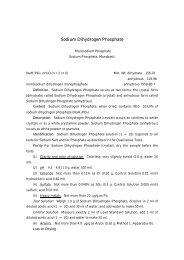Turmeric Oleoresin
Turmeric Oleoresin
Turmeric Oleoresin
You also want an ePaper? Increase the reach of your titles
YUMPU automatically turns print PDFs into web optimized ePapers that Google loves.
<strong>Turmeric</strong> <strong>Oleoresin</strong><br />
Curcumin<br />
Definition <strong>Turmeric</strong> <strong>Oleoresin</strong> consists mainly of curcumin, obtained from the<br />
ground rhizomes of turmeric. Commercial products may contain edible oils.<br />
Color Value The Color Value ( E 10%<br />
1cm ) of <strong>Turmeric</strong> <strong>Oleoresin</strong> is not less than 1,500<br />
and is in a range of 90110 % of the labeled value.<br />
Description <strong>Turmeric</strong> <strong>Oleoresin</strong> is yellow to dark red-brown powder, lumps,<br />
paste, or liquid having a characteristic odor.<br />
Identification (1) Weigh the equivalent of 0.1 g of <strong>Turmeric</strong> <strong>Oleoresin</strong>,<br />
calculated in terms of Color Value 1,500 from the labeled value, dissolve in 200ml of<br />
ethanol. A yellow color with a light-green fluorescence develops.<br />
(2) <strong>Turmeric</strong> oleoresin solution in ethanol exhibits an absorption maximum at a<br />
wavelength of 420nm430 nm.<br />
(3) Weigh the equivalent of 1 g of <strong>Turmeric</strong> <strong>Oleoresin</strong>, calculated in terms of<br />
Color Value 1,500 from the labeled value, dissolve in 100 ml of ethanol, and add<br />
hydrochloric acid until the color of the solution turns slightly orange. Use this solution<br />
as the test solution. Add boric acid to the test solution. A red-orange color develops.<br />
(4) Weigh the equivalent of 1 g of <strong>Turmeric</strong> <strong>Oleoresin</strong>, calculated in terms of<br />
Color Value 1,500 from the labeled value, dissolve in 100ml of ethanol, centrifuge the<br />
solution at 3,000 rpm for 10min. Use the supernatant as the test solution. Measure 5 µl<br />
of the test solution and perform Thin-Layer Chromatography without a control solution,<br />
using an isoamylalcoholethanolwaterammonia mixture (4 : 4 : 2 : 1) as the<br />
developing solvent. Two or more yellow spots are observed at Rf 0.40.85. All spots<br />
show yellow fluorescence under UV-light. For the thin-layer plate, use a plate prepared<br />
by applying silica gel for thin-layer chromatography, dried at 110 for 1 hour, as the<br />
support. Stop the development when the solvent front rises about 10 cm above the<br />
original line, air-dry, and observe under daylight and ultraviolet light (wavelength:<br />
about 366nm)<br />
Purity (1) Heavy metals Not more than 40 µg /g as Pb (0.50g, Method 2,<br />
Control solution Lead standard solution 2.0ml)<br />
(2) Lead Not more than 10 µg /g as Pb (1.0g, Method 1)<br />
(3) Arsenic Not more than 4.0 µg /g as AS2O3 (0.50g, Method 3, Apparatus B)
Color Value test Proceed as directed under the Color Value Test.<br />
Operating conditions<br />
Solvent: Ethanol.<br />
Wavelength: Absorption maximum at a wavelength of 420430nm.
















